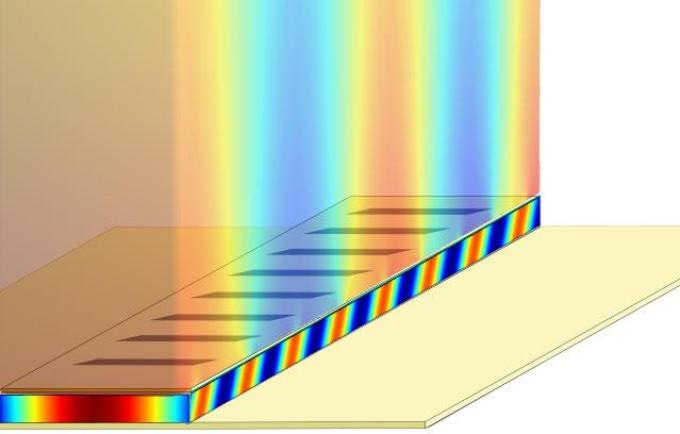Nov 1 2016
 In this illustration of a terahertz plasmonic laser, the laser cavity is enclosed between two metal films (with periodic slits on the top film). The colors represent coherent SPP light waves. One wave is confined inside the 10-micron-thick cavity. The other, with a large spatial extent, is located on top of the cavity. CREDIT: Lehigh University.
In this illustration of a terahertz plasmonic laser, the laser cavity is enclosed between two metal films (with periodic slits on the top film). The colors represent coherent SPP light waves. One wave is confined inside the 10-micron-thick cavity. The other, with a large spatial extent, is located on top of the cavity. CREDIT: Lehigh University.
Laser is a device that produces an intense beam of coherent electromagnetic radiation by the stimulation of photon emission from excited molecules or atoms. Although it was formerly the most desired weapon of space-fiction heroes as well as B-movie madmen, it has been highly domesticated in recent times.
Nowadays, it has found constant usage in industry, as well as for playback of movies in home theaters and for printing files in home offices. Although it finds a mention now and then in military news and medical journals, its use has been generally limited to barcode reading at grocery stores, a technology that has lost its sheen.
However, Sushil Kumar, an associate professor of electrical and computer engineering from Lehigh University, affirms that lasers are still impressive because they have immense innovation potential, tapping of which has just been initiated. With assistance from the National Science Foundation (NSF), he is working on an important assignment to demonstrate the same.
Kumar particularly pays attention to lasers that emerge from the terahertz (THz) or far infrared, frequency, which is a comparatively unexploited region of the electromagnetic spectrum. Being a scientist leading the THz semiconductor “quantum-cascade” laser technology, he along with his collaborators have published world-record outcomes for high-temperature operation and other salient performance characteristics of these lasers.
His main objective is to develop devices that can find a wide range of prospective applications such as quality control in pharmaceuticals, disease diagnosis, detection of explosives and other contraband materials, chemical and biological sensing, spectroscopy, and even remote-sensing in astronomy to perceive formation of galaxies and stars, among others.
Kumar adds that in spite of the familiar benefits, THz lasers are largely underexplored and underutilized because of the functional limitations and higher cost that have inhibited the innovation that can lead to its usage. Nevertheless, Kumar is convinced that he is on the right path to uncover the potential of THz lasers. He recently obtained a grant from the NSF for his work “Phase-locked arrays of high-power THz lasers with ultra-narrow beams,” with the objective of producing THz lasers that can generate highly enormous optical intensities than at present, and thus potentially eliminating obstacles in the large-scale research and commercial production.
Focusing on a solution
Kumar proposes that the THz region in the electromagnetic spectrum is substantially underdeveloped because of the absence of high-power radiation sources. The prevailing radiation sources are incompatible for commercial applications due to their low output power and other unfavorable spectral characteristics. Hence, his ongoing project revolves around developing THz semiconductor lasers with accurate emission frequency of up to 100mW of average optical power in a narrow beam with an angular divergence of notably less than 5°, which is an advancement of two orders of magnitude over the existing technology.
Kumar’s research deals with quantum cascade lasers (QCLs), which were initially developed for mid-infrared radiation emission. These lasers have only recently started to become successful at THz frequencies. However, they experience numerous other challenges in this range. Kumar’s team is one among very few in the world to make progress toward low-cost and viable production of these lasers in this cutting-edge environment.
Kumar’s calculated approach is sure to appreciably enhance the beam quality and power output of the QCL. The obligatory temperature-cooling of the semiconductor laser chips will be carried out by an electrically-operated, portable cryocooler. The laser chips will include phase-locked QCL arrays that emit at a wide range of discrete THz frequencies chosen by the desired application.
In a prior research, Kumar and his team exhibited that a focused beam of light can be produced by THz lasers that emit at a wavelength of nearly 100μm, by employing a method known as distributed feedback. In their laser, the light energy is confined to a cavity that is sandwiched between two metallic plates placed at a distance of 10μm from each other. The team produced a THz laser of just 4° x 4° beam divergence angle (the narrowest divergence attained for THz lasers to date) by using a box-shaped cavity with an area of 10μm x 100μm x 1400μm, i.e., 1.4mm.
Kumar affirms that many of the companies that use mid-infrared lasers at present would be curious to use the affordable and powerful THz QCL, and that the technology by itself will give rise to innovative solutions.
The iPhone needed to exist before developers could write the ‘killer apps’ that made it a household product. In the same way, we are working toward a technology that could allow future researchers to change the world in ways that have yet to even be considered.
Sushil Kumar, an associate professor of electrical and computer engineering from Lehigh University